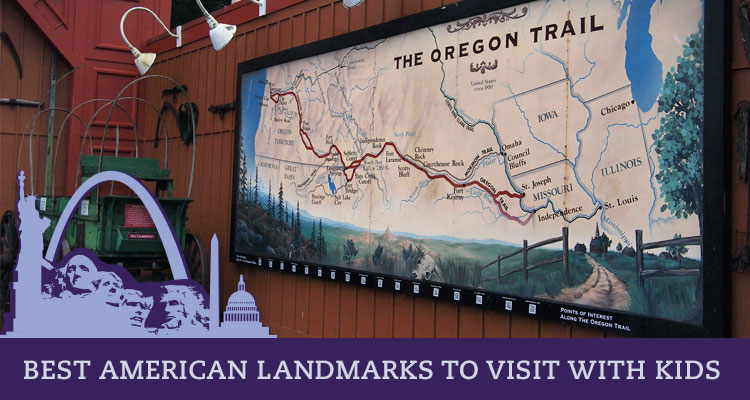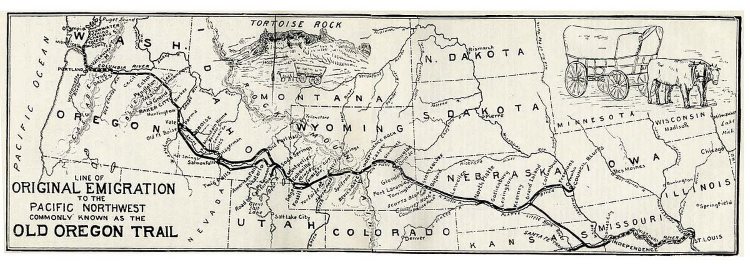America’s natural landmarks represent the diversity and beauty of this country’s natural landscape and a visit to any of them will inspire a child’s learning. Whether visiting a historic landmark to see firsthand the documents our nation was built on, or gazing in awe at the beauty found in our national parks, visits to these places are an opportunity for memorable family bonding and can bring history to life for a powerful learning experience. This series includes tips and educational resources for visiting some of the most amazing landmarks our country has to offer with your kids. Some may be in your backyard, while others require a longer trip, but all are well worth a visit.
The Oregon Trail embodies a new era in American history, one where significant opportunities presented a reason for many to leave their previous life behind in search of prosperity. Large plots of free land (a square mile for married men, 1/2 a square mile for single men) and a gold rush in California were but a few of the many prizes awaiting those who dared to make the 2,200 mile trek west from the Great Plains to Oregon Country.
When people think of the Oregon Trail, the classic Oregon Trail computer game may come to mind. This game has, in many cases, taught us to think of the journey rather than the destination. That destination for many who migrated west was the Willamette Valley, near what is now Portland, Oregon. Today, the Willamette Valley is home to 70 percent of Oregon’s total population, due to its fertile farm lands, mild weather, and proximity to multiple rivers that provide fresh water, fish, and commerce routes.
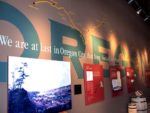
Today, Oregon City has a population of about 32,000 people and is home to the End of the Oregon Trail Interpretive Center, which provides a fantastic opportunity for students to learn about the reasons that so many traveled west, including living conditions before, during, and after the journey.
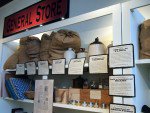
Activities to Include on Your Visit to The End of The Oregon Trail
Tours & Museums
Many of the historical sites around Northwest Oregon are available to the public and offer tours for individuals and groups. Many of the key locations around the area are:

The McLoughlin House: John McLoughlin was a key figure in the development of the Oregon Territory. The superintendent of the Hudson’s Bay Company, McLoughlin developed the fur trading market out of Fort Vancouver. The fur trade led to the migration of the first permanent white settlers in the area as many came to seek work in the profitable industry. McLoughlin was named the “Father of Oregon” after his death, and his home was turned into a museum in 1910. Tours are available Fridays and Saturdays from 10 AM until 4 PM.
Museum of the Oregon Territory: At this museum featuring all-things Oregon Territory, you can learn how the area has developed geologically over millions of years, and what life was like for native inhabitants for thousands of years. Finally, you will learn all about the significant economic and cultural developments over the 18th, 19th, and 20th centuries that led to the development of the Oregon Territory and much of the western United States. The museum is open Wednesdays thru Saturdays, 10:30 AM–4:30 PM.
Fort Vancouver: A fur-trading outpost along the Columbia River near Portland, Oregon, Fort Vancouver was the headquarters for the Hudson’s Bay Company Columbia Department as early as 1824, over a decade before the great migration west. The fort was a significant outpost in the west, comprised of 40 buildings inside the fort walls that included housing, a school, a pharmacy, a library, a blacksmith, and more. Outside the fort walls there were many more facilities supporting the activity of the Hudson’s Bay Company and early settlers. Today, a full-scale replica of the fort still stands near the banks of the Columbia River. Tours are available from roughly 9 AM–5 PM daily, with different hours on Sundays and during the summer.
Sights
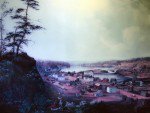
Columbia River Gorge: One of the most stunning natural landscapes in the country, the Columbia River Gorge was the harrowing final stretch for many travelers of the Oregon Trail. As the only sea-level passage through the Cascade Range, trail voyagers encountered swift rapids and high winds on the river, as little overland travel was possible due to heavy forest and sheer cliffs on the banks of the Columbia River. Wagons and supplies often had to be floated down the river, which was both expensive and highly dangerous. Once through the gorge, travelers found themselves in the Willamette Valley, the end of their long journey. There are numerous places to experience the Columbia River Gorge, including Crown Point, Multnomah Falls, and the town of Hood River. If you’re up for hiking, you can get great views from Angel’s Rest, Starvation Creek Overlook, and Beacon Rock among others. Beware that travel through the Columbia River Gorge can be treacherous in the winter, check conditions ahead of time.
Mount Hood: As the tallest mountain in Oregon and part of one of the largest mountain ranges in the United States, Mount Hood and the surrounding area presented many challenges to travelers of the Oregon Trail. Due to the dangers in the Columbia River Gorge, Samuel Barlow and Phillip Foster built the Barlow Road in 1846 as a safer route to the Willamette Valley from the high desert east of the Cascades. Today, parts of the Barlow Road still exist, and you can see them by traveling east from the Portland area on Highway 26 to Highway 35 and the Barlow Pass Sno Park area. Snowshoeing, cross country skiing, and hiking are available in the area. Beware that travel over and around Mount Hood can be treacherous in the winter—check conditions ahead of time.
Willamette Valley: When visiting the Willamette Valley, it’s easy to understand why so many traveled west to settle. Rolling hills, rivers, and forested areas provide ample resources for those in the area. You can visit cities such as Salem, Corvallis, and Eugene to the south, and take a drive through Oregon’s Wine Country to experience the landscape for yourself.
Related Educational Resources and Activities
Oregon Trail Classic Computer Game: The iconic game played by millions of children in elementary school computer labs is now available for free online. You can also play Oregon Trail Deluxe online as well, but both feature similar gameplay that requires players to prepare for the journey by purchasing tools, food, and supplies, then survive the journey by making decisions based on weather, landscape, and the health of the party.
Scholastic offers an Oregon Trail Web Quest on its site, which walks students through details of the conditions travelers found on their 2,000 mile journey along the trail.
Related Children’s Books
Children on the Oregon Trail is a book based on the Sager children who traveled the Oregon Trail in 1844. When John Sager’s parents die on the journey, he is left to look after his six sibling at the young age of 13.
If You Traveled West in a Covered Wagon offers a great opportunity for children to understand what life was like on the Oregon Trail during the 1840s. With a focus on the hardships faced by families on the trail, students will gain an understanding of this portion of American history.
Rachel’s Journal: The Story of a Pioneer Girl follows the story a young girl who travels from Illinois to California over a seven-month period. With detailed depictions of daily life and the hardships encountered along the way, from a child’s perspective.
Questions for Discussion
Before your visit, ask your children:
- Why did so many people decide to risk injury, sickness, and death to travel the trail?
- Considering the landscape between Missouri and Oregon, how would trail travelers cross mountain ranges, rivers, and deserts on foot?
- What items would you want to take with you on the trail, and why are they important?
- How should the wagon parties interact with native tribes along the trail, and how could they work together for mutual benefit?
- Considering there were no refrigerators at the time, what would people eat and how would they prepare the food?
After your visit, ask these questions for further discussion:
- Knowing that new towns had to be built at the end of the trail, what jobs do you think were most important to the community?
- What do you think life was like for those who settled in Oregon? Was it as good as they thought it would be?
- What were the greatest risks to those who traveled the trail? What about those who made it to the Willamette Valley?
